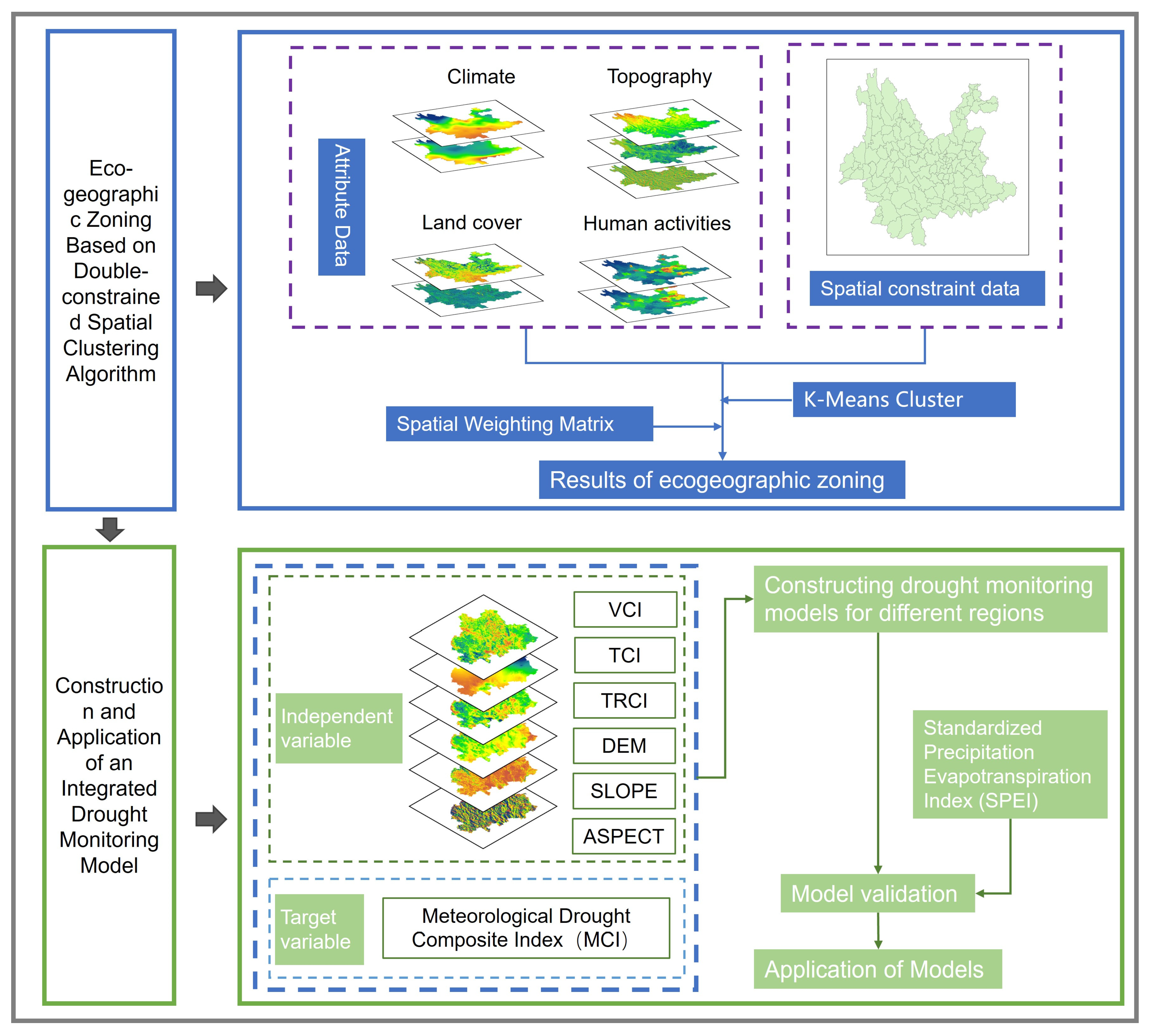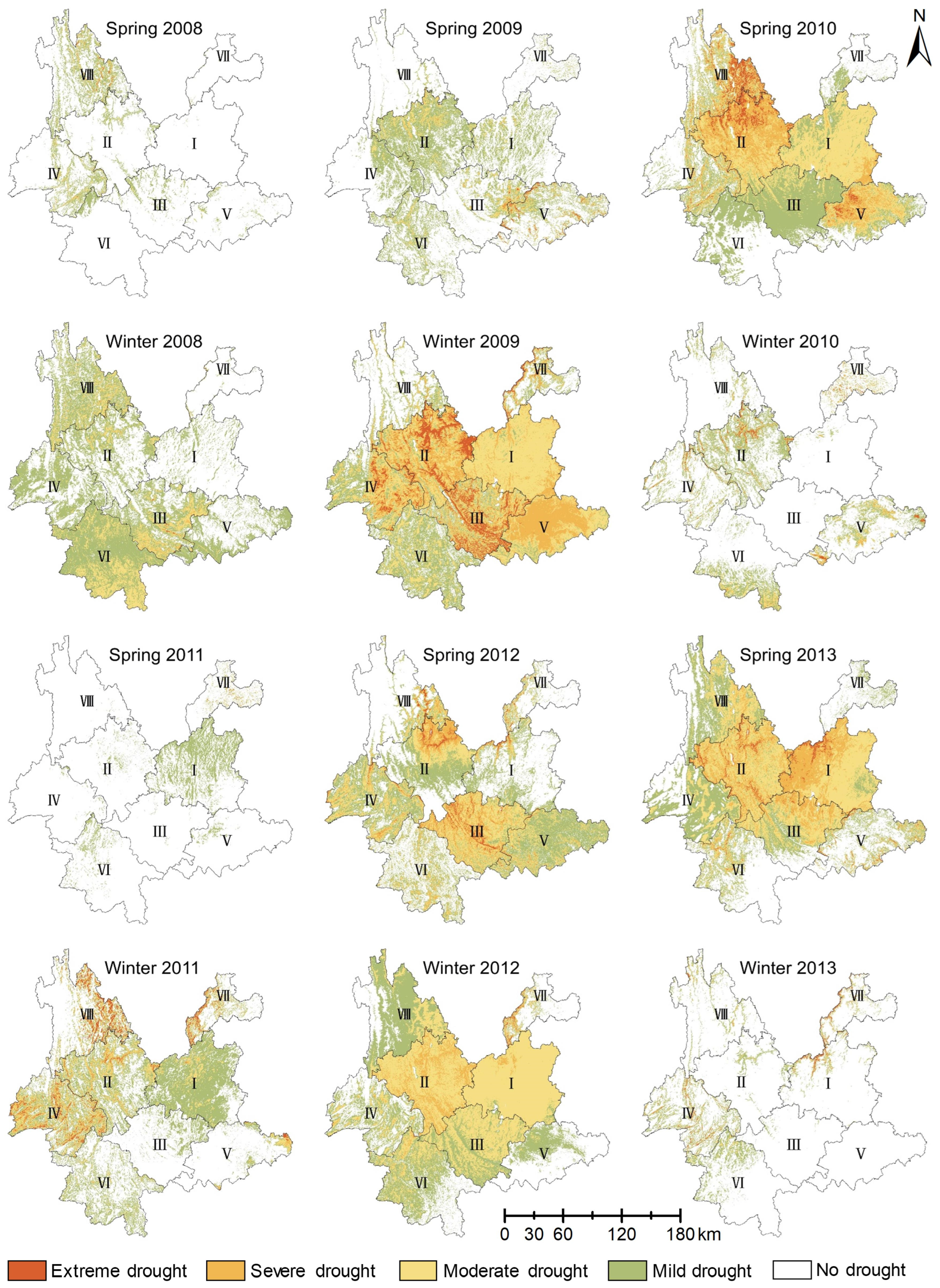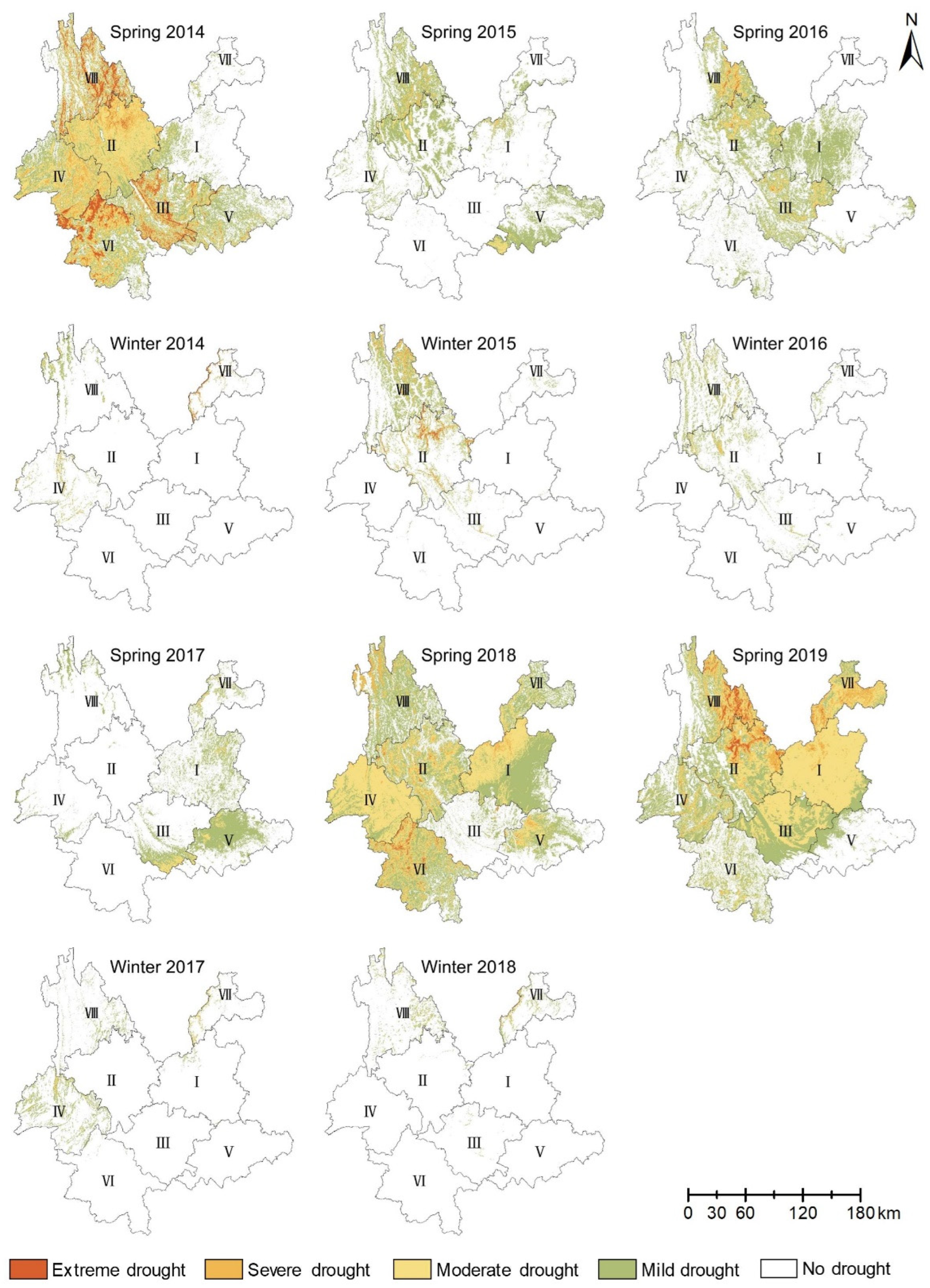Modeling and Application of Drought Monitoring with Adaptive Spatial Heterogeneity Using Eco–Geographic Zoning: A Case Study of Drought Monitoring in Yunnan Province, China
Abstract
:1. Introduction
2. Materials and Methods
2.1. Study Area
2.2. Data Descriptions and Preprocessing
2.2.1. Remote Sensing Data
2.2.2. Meteorological Data
2.2.3. Social and Economic Data
2.3. Methods
2.3.1. Construction of Ecological–Geographic Zoning Index System
2.3.2. Eco–Geographic Zoning Based on Dual-Constrained Spatial Clustering Algorithm
2.3.3. Construction of an Integrated Drought Monitoring Model Based on Eco–Geographic Zoning
2.3.4. Model Effectiveness Evaluation
3. Results and Analysis
3.1. Eco–Geographic Division of Yunnan Province
3.2. Verification of Comprehensive Drought Monitoring Model
3.3. Model Application: Spatial and Temporal Evolution and Analysis of Drought in Different Years in Yunnan Province
3.3.1. Characteristics of Drought Time Variations in Different Ecological and Geographical Regions
3.3.2. Spatial Variation Characteristics of Drought in Different Ecological and Geographical Regions
3.3.3. Analysis of Drought Areas in Different Ecological and Geographical Regions
3.3.4. Analysis of Drought Frequency in Different Eco–Geographic Regions
4. Discussion
5. Conclusions
Author Contributions
Funding
Data Availability Statement
Acknowledgments
Conflicts of Interest
References
- Alahacoon, N.; Edirisinghe, M. A comprehensive assessment of remote sensing and traditional based drought monitoring indices at global and regional scale. Geomat. Nat. Hazards Risk 2022, 13, 762–799. [Google Scholar] [CrossRef]
- Bhardwaj, J.; Kuleshov, Y.; Chua, Z.-W.; Watkins, A.B.; Choy, S.; Sun, C. Pairing monitoring datasets with probabilistic forecasts to provide early warning of drought in Australia. J. Hydrol. 2023, 626, 130259. [Google Scholar] [CrossRef]
- Liu, Y.; Liu, Y.; Wang, W. Inter-comparison of satellite-retrieved and Global Land Data Assimilation System-simulated soil moisture datasets for global drought analysis. Remote Sens. Environ. 2019, 220, 1–18. [Google Scholar] [CrossRef]
- Vicente-Serrano, S.M.; Quiring, S.M.; Peña-Gallardo, M.; Yuan, S.; Domínguez-Castro, F. A review of environmental droughts: Increased risk under global warming? Earth-Sci. Rev. 2020, 201, 102953. [Google Scholar] [CrossRef]
- Du, E.; Chen, F.; Jia, H.; Wang, L.; Yang, A. Spatiotemporal Evolution and Hysteresis Analysis of Drought Based on Rainfed-Irrigated Arable Land. Remote Sens. 2023, 15, 1689. [Google Scholar] [CrossRef]
- Yu, H.; Li, L.; Liu, Y.; Li, J. Construction of Comprehensive Drought Monitoring Model in Jing-Jin-Ji Region Based on Multisource Remote Sensing Data. Water 2019, 11, 1077. [Google Scholar] [CrossRef]
- Tran, A.P.; Tran, B.C.; Campbell, S.B.; Nguyen, N.A.; Tran, D.H.; Nguyen, T.T.; Nguyen, A.D.; Duong, H.S. Spatio-temporal characterization of drought variability in data-scarce regions using global precipitation data: A case study in Cauto river basin, Cuba. Sci. Rep. 2024, 14, 11659. [Google Scholar] [CrossRef]
- Khosravi, Y.; Homayouni, S.; St-Hilaire, A. An integrated dryness index based on geographically weighted regression and satellite earth observations. Sci. Total Environ. 2024, 911, 168807. [Google Scholar] [CrossRef]
- Tapas, M.R.; Kumar, U.; Mogili, S.; Jayakumar, K. Development of multivariate integrated drought monitoring index (MIDMI) for Warangal region of Telangana, India. J. Water Clim. Chang. 2022, 13, 1612–1630. [Google Scholar] [CrossRef]
- Jiao, W.; Zhang, L.; Chang, Q.; Fu, D.; Cen, Y.; Tong, Q. Evaluating an enhanced vegetation condition index (VCI) based on VIUPD for drought monitoring in the continental United States. Remote Sens. 2016, 8, 224. [Google Scholar] [CrossRef]
- Brown, J.F.; Wardlow, B.D.; Tadesse, T.; Hayes, M.J.; Reed, B.C. The Vegetation Drought Response Index (VegDRI): A new integrated approach for monitoring drought stress in vegetation. GIScience Remote Sens. 2008, 45, 16–46. [Google Scholar] [CrossRef]
- Mehta, D.J.; Yadav, S. Trend analysis of drought events over the Sirohi District in Western Rajasthan of India. In International Conference on Hydraulics, Water Resources and Coastal Engineering; Springer Nature Singapore: Singapore, 2021; pp. 257–269. [Google Scholar]
- Mehta, D.J.; Yadav, S. Meteorological drought analysis in Pali District of Rajasthan State using standard precipitation index. Int. J. Hydrol. Sci. Technol. 2023, 15, 1–10. [Google Scholar] [CrossRef]
- Ayantobo, O.O.; Li, Y.; Song, S.; Javed, T.; Yao, N. Probabilistic modelling of drought events in China via 2-dimensional joint copula. J. Hydrol. 2018, 559, 373–391. [Google Scholar] [CrossRef]
- Fitriyah, A.; Fatikhunnada, A.; Okura, F.; Nugroho, B.D.A.; Kato, T. Analysis of the Drought Mitigated Mechanism in Terraced Paddy Fields Using CWSI and TVDI Indices and Hydrological Monitoring. Sustainability 2019, 11, 6897. [Google Scholar] [CrossRef]
- Cunha, A.; Alvalá, R.C.; Nobre, C.A.; Carvalho, M.A. Monitoring vegetative drought dynamics in the Brazilian semiarid region. Agric. For. Meteorol. 2015, 214, 494–505. [Google Scholar] [CrossRef]
- Hao, Z.; AghaKouchak, A. A nonparametric multivariate multi-index drought monitoring framework. J. Hydrometeorol. 2014, 15, 89–101. [Google Scholar] [CrossRef]
- Yu, H.; Li, L.; Li, J. Construction of a comprehensive drought monitoring model based on TRMM downscaling and MODIS data. J. Nat. Resour. 2020, 35, 2553–2568. [Google Scholar]
- Zhong, R.; Chen, X.; Lai, C.; Wang, Z.; Lian, Y.; Yu, H.; Wu, X. Drought monitoring utility of satellite-based precipitation products across mainland China. J. Hydrol. 2019, 568, 343–359. [Google Scholar] [CrossRef]
- Lee, S.-J.; Kim, N.; Lee, Y. Development of Integrated Crop Drought Index by Combining Rainfall, Land Surface Temperature, Evapotranspiration, Soil Moisture, and Vegetation Index for Agricultural Drought Monitoring. Remote Sens. 2021, 13, 1778. [Google Scholar] [CrossRef]
- Amani, M.; Salehi, B.; Mahdavi, S.; Masjedi, A.; Dehnavi, S. Temperature-vegetation-soil moisture dryness index (TVMDI). Remote Sens. Environ. 2017, 197, 1–14. [Google Scholar] [CrossRef]
- Liu, Q.; Zhang, S.; Zhang, H.; Bai, Y.; Zhang, J. Monitoring drought using composite drought indices based on remote sensing. Sci. Total Environ. 2020, 711, 134585. [Google Scholar] [CrossRef] [PubMed]
- Mousavi, R.; Johnson, D.; Kroebel, R.; Byrne, J. Analysis of historical drought conditions based on SPI and SPEI at various timescales in the South Saskatchewan River Watershed, Alberta, Canada. Theor. Appl. Climatol. 2023, 153, 873–887. [Google Scholar] [CrossRef]
- Tan, M.L.; Tan, K.C.; Chua, V.P.; Chan, N.W. Evaluation of TRMM product for monitoring drought in the Kelantan River Basin, Malaysia. Water 2017, 9, 57. [Google Scholar] [CrossRef]
- Quiring, S.M.; Ganesh, S. Evaluating the utility of the Vegetation Condition Index (VCI) for monitoring meteorological drought in Texas. Agric. For. Meteorol. 2010, 150, 330–339. [Google Scholar] [CrossRef]
- Zhang, X.; Chen, N.; Li, J.; Chen, Z.; Niyogi, D. Multi-sensor integrated framework and index for agricultural drought monitoring. Remote Sens. Environ. 2017, 188, 141–163. [Google Scholar] [CrossRef]
- Bailey; Robert, G. Explanatory Supplement to Ecoregions Map of the Continents. Environ. Conserv. 1989, 16, 307–309. [Google Scholar] [CrossRef]
- Fu, B.; Chen, L.; Liu, G. The purpose, tasks, and characteristics of ecological regionalization in China. Acta Ecol. Sin. 1999, 5, 591–595. [Google Scholar]
- Fu, B.; Liu, G.; Chen, L.; Ma, K.; Li, J. The ecological regionalization plan for China. Acta Ecol. Sin. 2001, 1, 1–6. [Google Scholar]
- Piniarski, W. Challenges of a GIS-based physical-geographical regionalization of Poland. Environ. Monit. Assess. 2023, 195, 1125. [Google Scholar] [CrossRef]
- Murray, A.T.; Grubesic, T.H.; Wei, R. Spatially significant cluster detection. Spat. Stat. 2014, 10, 103–116. [Google Scholar] [CrossRef]
- Kaufman, L.; Rousseeuw, P.J. Finding Groups in Data: An Introduction to Cluster Analysis; John Wiley & Sons: Hoboken, NJ, USA, 2009. [Google Scholar]
- Fritz, C.E.; Schuurman, N.; Robertson, C.; Lear, S. A scoping review of spatial cluster analysis techniques for point-event data. Geospat. Health 2013, 7, 183–198. [Google Scholar] [CrossRef]
- Ke, X.; Qi, L.; Zeng, C. A partitioned and asynchronous cellular automata model for urban growth simulation. Int. J. Geogr. Inf. Sci. 2016, 30, 637–659. [Google Scholar] [CrossRef]
- Xu, Q.; Wang, Q.; Liu, J.; Liang, H. Simulation of Land-Use Changes Using the Partitioned ANN-CA Model and Considering the Influence of Land-Use Change Frequency. Int. J. Geo-Inf. 2021, 10, 346. [Google Scholar] [CrossRef]
- Administration, C.M. GB/T 20481-2017 Meteorological Drought Level; Meteorol. Press: Beijing, China, 2017. [Google Scholar]
- Molavizadeh, N.; Sertel, E.; Demirel, H. Drought Conditions in Turkey between 2004 and 2013 Via Drought Indices Derived from Remotely Sensed Data. In Energy, Transportation and Global Warming; Springer: Berlin/Heidelberg, Germany, 2016; pp. 113–121. [Google Scholar]
- Ashouri, H.; Hsu, K.-L.; Sorooshian, S.; Braithwaite, D.K.; Knapp, K.R.; Cecil, L.D.; Nelson, B.R.; Prat, O.P. PERSIANN-CDR: Daily precipitation climate data record from multisatellite observations for hydrological and climate studies. Bull. Am. Meteorol. Soc. 2015, 96, 69–83. [Google Scholar] [CrossRef]
- Sindosi, O.; Bartzokas, A.; Kotroni, V.; Lagouvardos, K. Influence of orography on precipitation amount and distribution in NW Greece; a case study. Atmos. Res. 2015, 152, 105–122. [Google Scholar] [CrossRef]
- Li, S.; Xu, Q.; Yi, J.; Liu, J. Construction and application of comprehensive drought monitoring model considering the influence of terrain factors: A case study of southwest Yunnan, China. Environ. Sci. Pollut. Res. 2022, 29, 72655–72669. [Google Scholar] [CrossRef]
- Vicente-Serrano, S.M.; Beguería, S.; López-Moreno, J.I. A multiscalar drought index sensitive to global warming: The standardized precipitation evapotranspiration index. J. Clim. 2010, 23, 1696–1718. [Google Scholar] [CrossRef]
- Mehta, D.; Yadav, S.; Ladavia, C.; Caloiero, T. Drought projection using GCM & statistical downscaling technique: A case study of Sirohi District. Results Eng. 2023, 20, 101605. [Google Scholar]
- Shen, R.; Huang, A.; Li, B.; Guo, J. Construction of a drought monitoring model using deep learning based on multi-source remote sensing data. Int. J. Appl. Earth Obs. Geoinf. 2019, 79, 48–57. [Google Scholar]
- Stefanidis, S.; Rossiou, D.; Proutsos, N. Drought severity and trends in a Mediterranean oak forest. Hydrology 2023, 10, 167. [Google Scholar] [CrossRef]
- Li, J. Assessing the accuracy of predictive models for numerical data: Not r nor r2, why not? Then what? PLoS ONE 2017, 12, e0183250. [Google Scholar] [CrossRef] [PubMed]
- Li, J. Assessing spatial predictive models in the environmental sciences: Accuracy measures, data variation and variance explained. Environ. Model. Softw. 2016, 80, 1–8. [Google Scholar] [CrossRef]
- Ke, X.; Liu, M.; Deng, X. Lake nutrient ecological zoning: A zoning experiment in Northeast China. J. Nat. Resour. 2014, 29, 789–800. [Google Scholar]
- Zhang, Q.F.; Wu, F.Q.; Wang, L.; Yuan, L.; Zhao, L.S. Application of PCA integrated with CA and GIS in eco-economic regionalization of Chinese Loess Plateau. Ecol. Econ. 2011, 70, 1051–1056. [Google Scholar] [CrossRef]
- Xu, T.; Li, E.; Samat, A.; Li, Z.; Liu, W.; Zhang, L. Estimating Large-Scale Interannual Dynamic Impervious Surface Percentages Based on Regional Divisions. Remote Sens. 2022, 14, 3786. [Google Scholar] [CrossRef]
- Jiao, L.; Liu, Y.; Ren, Z. Spatial point clustering based on self-organizing neural networks and its application analysis. Geomat. Inf. Sci. Wuhan Univ. 2008, 2, 168–171. [Google Scholar]
- Zhang, Q.; Shi, R.; Xu, C.Y.; Sun, P.; Yu, H.; Zhao, J. Multisource data-based integrated drought monitoring index: Model development and application. J. Hydrol. 2022, 615, 128644. [Google Scholar] [CrossRef]
- Nichol, J.E.; Abbas, S. Integration of remote sensing datasets for local scale assessment and prediction of drought. Sci. Total Environ. 2015, 505, 503–507. [Google Scholar] [CrossRef]
- Zhang, L.; Jiao, W.; Zhang, H.; Huang, C.; Tong, Q. Studying drought phenomena in the Continental United States in 2011 and 2012 using various drought indices. Remote Sens. Environ. 2017, 190, 96–106. [Google Scholar] [CrossRef]
- Yu, Y.; Shen, Y.; Wang, J.; Wei, Y.; Nong, L.; Deng, H. Assessing the response of vegetation change to drought during 2009–2018 in Yunnan Province, China. Environ. Sci. Pollut. Res. 2021, 28, 47066–47082. [Google Scholar] [CrossRef]








| Main Factors | Zoning Indicators | Indicator Description | Data Sources |
|---|---|---|---|
| Climate | Annual precipitation | Characterize the regional hydrothermal conditions. | China Meteorological Data Network (http://cdc.cma.gov.cn) |
| Annual average temperature | |||
| Topography | DEM | Characterize the regional landform environment. | Geo Space Cloud (http://www.gscloud.cn) |
| Slope | |||
| Aspect | |||
| Land cover | Land use types | Characterize the regional vegetation conditions. | Chinese Academy of Sciences Resource and Environment Science Data Center platform (http://www.resdc.cn) |
| NDVI | |||
| Social and economic | Population density | Characterizing the influence exerted by social and economic development on the ecological environment. | |
| GDP |
| Drought Index | Formula | Indicator Description | Notes |
|---|---|---|---|
| VCI | NDVIi, LSTi, TRMMi represent the NDVI, land surface temperature, and precipitation values for the ith quarter of a certain year, “max” and “min” refer to the maximum and minimum values of the NDVI, land surface temperature, and precipitation for the ith quarter within the study period. | The above indices and correlation coefficients are calculated with reference to the latest revision of the “Meteorological Drought Grade” [36]. | |
| TCI | |||
| TRCI | |||
| MCI | SPIW60 is the standardized weighted precipitation index in the past 60 days; MI30 is the relative humidity index over the past 30 days; SPI90 and SPI150 respectively signify the standardized precipitation indices for the past 90 and 150 days; a, b, c, and d stand for weight coefficients; Ka is utilized as the seasonal adjustment factor. |
| Model Type | Unpartitioned Model | Partitioned Model | |||||||
|---|---|---|---|---|---|---|---|---|---|
| I | II | III | IV | V | VI | VII | VIII | ||
| R | 0.548 | 0.669 | 0.701 | 0.747 | 0.749 | 0.743 | 0.828 | 0.490 | 0.534 |
| RMSE | 0.85 | 0.777 | 0.727 | 0.696 | 0.654 | 0.703 | 0.581 | 0.885 | 0.822 |
| R Raise % | 22.08 | 27.92 | 36.31 | 36.68 | 35.58 | 51.09 | −10.58 | −2.55 | |
| RMSE Reduction % | 8.59 | 14.47 | 18.12 | 23.06 | 17.29 | 31.65 | −4.12 | −3.76 | |
| Drought Index | Extreme Drought | Severe Drought | Moderate Drought | Light Drought | No Drought |
|---|---|---|---|---|---|
| CDI | CDI < −2 | −2 < CDI < −1.5 | −1.5 < CDI < −1 | 1 < CDI < −0.5 | −0.5 < CDI |
| I | II | III | IV | V | VI | VII | VIII | |
|---|---|---|---|---|---|---|---|---|
| Extreme drought | 0.00 | 0.00 | 0.00 | 0.56 | 0.00 | 0.00 | 0.83 | 0.00 |
| Severe drought | 2.43 | 5.16 | 4.17 | 5.56 | 1.28 | 1.92 | 1.67 | 1.67 |
| Moderate drought | 32.64 | 25.79 | 26.85 | 15.56 | 8.33 | 25.64 | 5.83 | 5.00 |
| Light drought | 23.26 | 33.33 | 29.17 | 15.56 | 42.95 | 18.59 | 21.67 | 25.83 |
| No drought | 41.67 | 35.71 | 39.81 | 62.78 | 47.44 | 53.85 | 70.00 | 67.50 |
| I | II | III | IV | V | VI | VII | VIII | |
|---|---|---|---|---|---|---|---|---|
| Extreme drought | 0.00 | 0.00 | 0.00 | 0.00 | 0.00 | 0.7 | 0.00 | 0.00 |
| Severe drought | 0.42 | 5.19 | 0.51 | 2.42 | 10.49 | 9.09 | 1.82 | 0.91 |
| Moderate drought | 19.17 | 12.55 | 10.10 | 14.55 | 7.69 | 9.09 | 2.73 | 6.36 |
| Light drought | 9.17 | 9.09 | 18.69 | 10.30 | 5.59 | 13.29 | 5.45 | 14.55 |
| No drought | 71.25 | 73.16 | 70.71 | 72.73 | 76.22 | 67.83 | 80.91 | 78.18 |
Disclaimer/Publisher’s Note: The statements, opinions and data contained in all publications are solely those of the individual author(s) and contributor(s) and not of MDPI and/or the editor(s). MDPI and/or the editor(s) disclaim responsibility for any injury to people or property resulting from any ideas, methods, instructions or products referred to in the content. |
© 2024 by the authors. Licensee MDPI, Basel, Switzerland. This article is an open access article distributed under the terms and conditions of the Creative Commons Attribution (CC BY) license (https://creativecommons.org/licenses/by/4.0/).
Share and Cite
Xu, Q.; Li, S.; Yi, J.; Wang, X. Modeling and Application of Drought Monitoring with Adaptive Spatial Heterogeneity Using Eco–Geographic Zoning: A Case Study of Drought Monitoring in Yunnan Province, China. Water 2024, 16, 2500. https://doi.org/10.3390/w16172500
Xu Q, Li S, Yi J, Wang X. Modeling and Application of Drought Monitoring with Adaptive Spatial Heterogeneity Using Eco–Geographic Zoning: A Case Study of Drought Monitoring in Yunnan Province, China. Water. 2024; 16(17):2500. https://doi.org/10.3390/w16172500
Chicago/Turabian StyleXu, Quanli, Shan Li, Junhua Yi, and Xiao Wang. 2024. "Modeling and Application of Drought Monitoring with Adaptive Spatial Heterogeneity Using Eco–Geographic Zoning: A Case Study of Drought Monitoring in Yunnan Province, China" Water 16, no. 17: 2500. https://doi.org/10.3390/w16172500
APA StyleXu, Q., Li, S., Yi, J., & Wang, X. (2024). Modeling and Application of Drought Monitoring with Adaptive Spatial Heterogeneity Using Eco–Geographic Zoning: A Case Study of Drought Monitoring in Yunnan Province, China. Water, 16(17), 2500. https://doi.org/10.3390/w16172500






